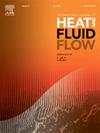花键中间通道间隙对内壁薄膜冷却性能和空气动力学特性影响的实验和数值研究
IF 2.6
3区 工程技术
Q2 ENGINEERING, MECHANICAL
International Journal of Heat and Fluid Flow
Pub Date : 2024-11-26
DOI:10.1016/j.ijheatfluidflow.2024.109671
引用次数: 0
摘要
从中间通道间隙流出的冷却剂被证明能为端壁表面提供额外的冷却,许多学者对此进行了研究。大多数研究都集中在直通道中间间隙上。本文介绍了不同类型的花键中段间隙,并对其进行了实验和数值研究,质量流量比范围为 0.5% 至 1.5%。采用压敏涂料技术评估了薄膜冷却性能,并进行了数值模拟以预测空气动力学性能。结果表明,与直线中段间隙相比,花键中段间隙能明显改善薄膜冷却性能,而花键中段间隙的曲率会影响薄膜冷却效果的峰值和冷却剂覆盖面积。后点式可获得最大的薄膜冷却效果值,而中点式可获得最广的冷却液覆盖范围。更重要的是,后点情况也会导致较大的空气动力损失,而中心点情况则可以在较大的质量流量比下获得更好的冷却-空气动力性能。本文章由计算机程序翻译,如有差异,请以英文原文为准。
Experimental and numerical investigation into the effects of spline mid-passage gap on endwall film cooling performance and aerodynamic characteristics
The coolant leakage flowing out from the mid-passage gap has been proved to offer an extra cooling to the endwall surface and was investigated by many scholars. While most studies focused on the straight mid-passage gap. In this paper, different types of spline mid-passage gap were introduced and studied experimentally and numerically, with the mass flow ratio ranged from 0.5% to 1.5%. Pressure sensitive paint technique was adopted to evaluate the film cooling performance, and numerical simulation was carried out to predict the aerodynamic performance. The results showed that compared to straight mid-passage gap, spline mid-passage gap can obviously improve the film cooling performance, and the curvature of the spline mid-passage gap will affect the peak value of the film cooling effectiveness and area of the coolant coverage. Back point case can achieve the maximum value of film cooling effectiveness, while center point case can achieve widest coolant coverage. What’s more, Back point case will also lead to larger aerodynamic loss and center point case can obtain better cooling-aerodynamic performance at a larger mass flow ratio.
求助全文
通过发布文献求助,成功后即可免费获取论文全文。
去求助
来源期刊

International Journal of Heat and Fluid Flow
工程技术-工程:机械
CiteScore
5.00
自引率
7.70%
发文量
131
审稿时长
33 days
期刊介绍:
The International Journal of Heat and Fluid Flow welcomes high-quality original contributions on experimental, computational, and physical aspects of convective heat transfer and fluid dynamics relevant to engineering or the environment, including multiphase and microscale flows.
Papers reporting the application of these disciplines to design and development, with emphasis on new technological fields, are also welcomed. Some of these new fields include microscale electronic and mechanical systems; medical and biological systems; and thermal and flow control in both the internal and external environment.
 求助内容:
求助内容: 应助结果提醒方式:
应助结果提醒方式:


